There’s been a recent viral TikTok video from Santa Cruz Medicinals, a CBD brand that sells skincare. In it, their founder claims CeraVe is “trash” because it contains propylparaben.
Here’s what he says in the video:
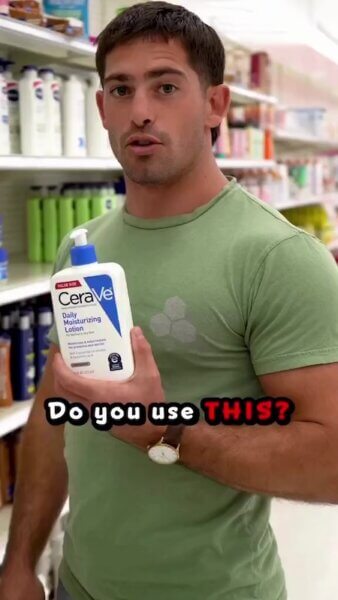
“Do you use this?
This contains propylparaben.
Propylparaben is an estrogen-like compound that is under the class of what we call parabens.
Women who are trying to get pregnant or breastfeeding are told to avoid parabens.
This is because they are being researched to disrupt hormone function in a negative way.
Parabens are in a lot of cosmetic products, and I would not want to rub these onto my skin, which is my body’s largest organ.
Especially as a man, when you introduce an estrogen-like compound, it can disrupt your testosterone levels.
So, I don’t use this. I think this is trash.”
I’ve done a video debunking this TikTok, along with some other fearmongering TikToks here. If you prefer reading, keep scrolling…
Why are people scared of parabens?
Watching this TikTok kind of made me feel like I was back in the early 2010s.
Parabens are highly effective preservatives that have been used for decades. However, parabens were one of the first ingredient classes that got demonized by the natural beauty movement and then the clean beauty movement.
Related post: Clean Beauty Is Wrong and Won’t Give Us Safer Products
All of this was sparked by a study in 2004, which found that parabens were in breast cancer tissue. The lead researcher Philippa Darbre has done a lot of research that’s gotten blown out of proportion.
Related post: Should you avoid aluminium in deodorants? The science (with video)
There were a lot of issues with this study.
First off, they only looked at breast cancer tissue, without comparing it with healthy tissue. Parabens could be present in both.
Even if you only found the parabens in the breast cancer tissue, it doesn’t mean that parabens are causing cancer. There are a lot of alternative explanations:
- Cancer tissue could to collect parabens more
- Some other cause could be introducing parabens along with a different cancer-causing ingredient
- They could completely unrelated
Correlation isn’t causation – for example, the number of Nicolas Cage films correlates quite well with pool drownings:
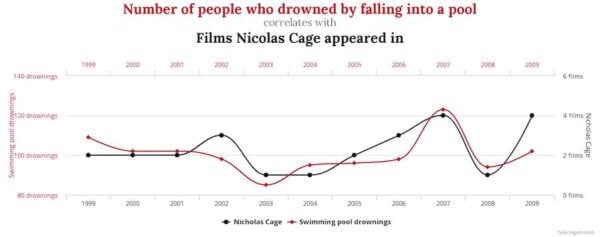
On top of that, the study measured parabens in blank samples that didn’t actually have any tissue at all – in some cases the blank samples actually had higher levels than the cancer tissue!

So really, this study is just showing that parabens are used a lot, including in the detergents used to clean lab equipment (the likely source of the parabens in the blanks).
Related post: Should You Be Avoiding Parabens? The Science
But despite these glaring issues, this study got a LOT of attention. It was reported in newspapers, in forwarded emails, on Facebook…
So this idea that parabens are bad and they’re related to breast cancer is firmly entrenched, and it just keeps spreading.
And because companies respond to consumer demand, there are barely any products on the market these days that use parabens. He just happened to pick up one of the ones that does.
Clever wording that hints at danger
There are also a bunch of phrases in this TikTok video that are worded very carefully – kind of like “weasel phrases”. I’m not sure he’s even aware he’s doing this.
“Women that are trying to get pregnant or breastfeeding are told to avoid parabens.”
Who is telling them? Are they misinformed? Is it just him telling them?
Some IVF clinics and endocrinologists (doctors who specialize in hormones) give their patients recommendations to avoid particular ingredients like parabens. But this isn’t part of their expertise, so they don’t necessarily have a thorough understanding of ingredients in skincare and their impact. They’re often going off internet sources just like anyone else (and this guy).
One of my friends is a practicing endocrinologist, and I recently confirmed that she’s never been taught anything about endocrine disruptors in skincare.
The fact that parabens haven’t made it into the medical syllabus despite their widespread use for over 100 years is actually a good indication that they probably don’t have that much of an impact.
“This is because they are being researched to disrupt hormone function in a negative way.”
Who was researching this? Is it a scientist? Is it just this guy googling? What were the findings of this research?
This phrase is a bit like “someone is being sued.” It isn’t that hard to sue someone, so it doesn’t mean much (except that someone either doesn’t like you or thinks you have deep pockets).
Are parabens hormone disruptors?
In the video, he says they’re “estrogen-like”, but without specifying how they’re similar to estrogen.
The estrogenic activity of parabens is generally thousands of times less strong than natural estrogen to begin with.
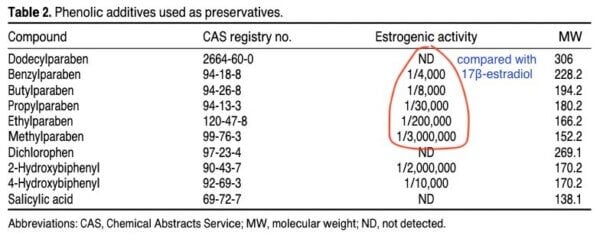
In the EU, there’s a body called the Scientific Committee on Consumer Safety (SCCS) who look at the safety of different ingredients going into cosmetics.
They reviewed all of the evidence on propylparaben in 2021 as part of a re-evaluation of potential endocrine disruptors, which I’ve mentioned before in the context of sunscreens.
They concluded that propylparaben is safe when used in skin care products at the previously recommended concentrations.
Don’t parabens in different products add up?
Whenever I talk about ingredient safety, I always get a lot of comments asking, “Don’t the amounts add up if you use more than one product?”
I think people tend to forget that the toxicologists who do these assessments are also normal people, with normal lives outside of their work. They go home and use products too. They have partners and kids who use multiple products.
Exposure to common ingredients through the use of multiple products is not a revelation. It’s called aggregate exposure, and it’s something that’s taken into account in safety assessments.
Related post: US Sunscreens Aren’t Safe in the EU? The Science
As part of this 2021 evaluation, the SCCS looked at what happened if you used 17 different products a day, all with the maximum allowed concentration of propylparaben. They found that you would still get 12500 times less than an exposure that they would still consider safe:
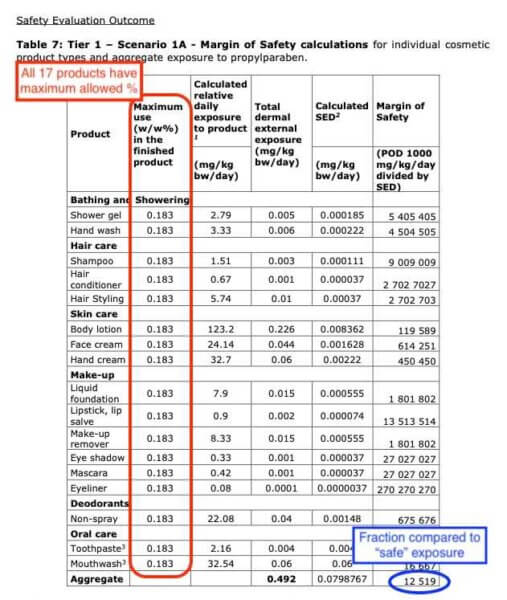
While this evaluation is specific to the EU regulatory limits, responsible formulations everywhere would be using similar concentrations, and certainly not more than 12500 times more.
Reality check for fearmongering
I think a lot of people forget to do a reality check when they accuse giant brands of trying to destroy their health after using an ingredient scanning app.
In general, big brands like CeraVe make pretty much the safest products you can buy. They hire hundreds or even thousands of scientists.
If it was this easy for a person who has zero science background to pick up a product, look at the ingredient list and KNOW that it’s unsafe, the company wouldn’t have released the product.
The product goes through approval by lots of different people, including many scientists, regulatory experts, toxicologists and lawyers. Liability and risk is a big consideration.
On top of that, dermatologists frequently recommend CeraVe. There’s just no chance that so many of them are going around recommending something that’s obviously harmful.
Lots of exposure through skin?
Another thing that bothers me is that he mentions that the skin is “the body’s largest organ”, implying that this makes it especially risky.
Firstly, he’s talking about a face cleanser – your face is only 4% of your body’s surface area (although I guess it depends on how big your face is?)
Additionally, skin’s main function is to act as a barrier. It would be really bad if skin absorbed everything really efficiently, simply because it’s big.
Related post: The “60% of products absorb into your bloodstream” myth
It would probably be safer to rub something all over your skin compared to rubbing it on, I don’t know, your pancreas. It’ll probably also be a lot safer to actually reach it.
Why are there so many male supermarket lecturers?
In my original response to this TikTok, I said that I really hate this genre of dudes who don’t understand science lecturing people on science while holding products in supermarkets.
A handful of people got really annoyed at me because of “reverse sexism”. But if you’ve been on TikTok for long enough, you’ll know that there’s a huge overrepresentation of male supermarket lecturers in viral videos.
It might be because more men film supermarket videos (maybe they don’t actually own skin care so they can’t film at home?), or the algorithm is picking up more dudes lecturing in supermarkets because people are more willing to trust this information at face value when it’s a man (there’s even more when it comes to food – check out @foodsciencebabe debunking those).
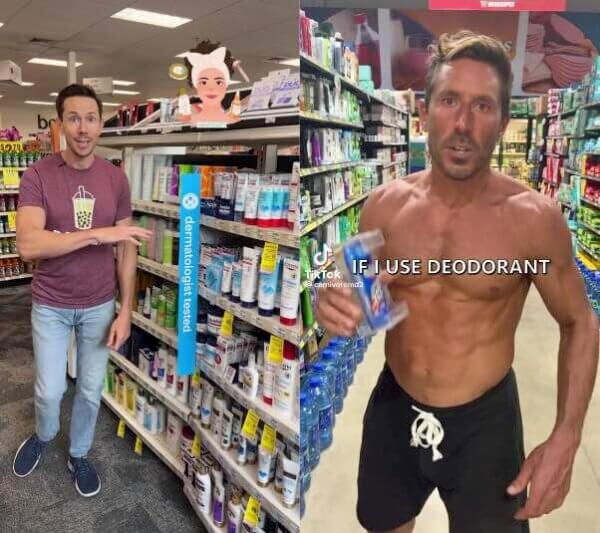
Women obviously make fearmongering pseudoscientific TikTok videos that blow up too, but they’re not in this genre.
A common theme is a woman in her bathroom or her bedroom, holding up a product she uses. Sometimes she’s throwing out a bunch of products.
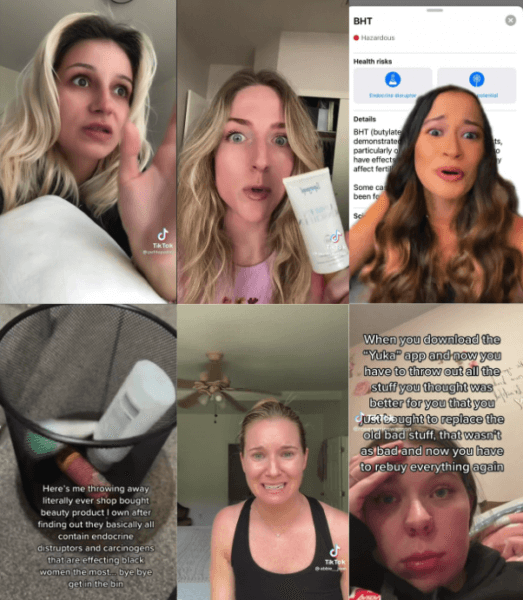
Often there’s a big emotional component, with the woman getting really upset, with tears in her eyes and sometimes a shaky voice. The narration will often say something like “I never realised there were all these chemicals in my products” “What are they doing to us?”
Social media algorithms respond to signals from people, and people have biases. There’s plenty of research showing that people tend to believe technical information when it comes from a man, and that people accept overt emotional displays like crying more from a woman than from a man.
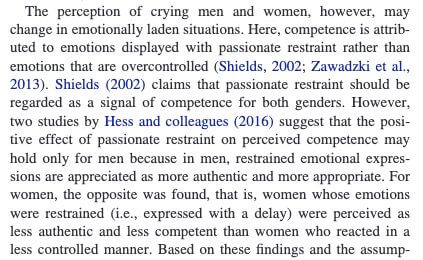
We live in a society. Even if you think you’re 100% objective and rational and not sexist, there are tons of people out there who are, and their combined reactions are influencing these algorithms that determine what gets shown on people’s feeds.
The full video is here – article versions of the other videos are coming soon!
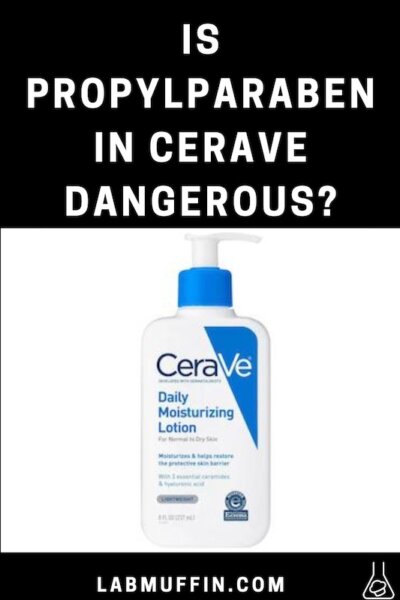
References
Darbre PD, Aljarrah A, Miller WR, Coldham NG, Sauer MJ, Pope GS. Concentrations of parabens in human breast tumours. J Appl Toxicol. 2004;24(1):5-13. doi:10.1002/jat.958
Miller D, Wheals BB, Beresford N, Sumpter JP. Estrogenic activity of phenolic additives determined by an in vitro yeast bioassay (open access). Environ Health Perspect. 2001;109(2):133-138. doi: 10.1289/ehp.109-1240632
SCCS Members. Opinion of the Scientific Committee on Consumer Safety (SCCS) – Final Opinion on propylparaben (CAS No 94-13-3, EC No 202-307-7). Regul Toxicol Pharmacol. 2021;125:105005. doi:10.1016/j.yrtph.2021.105005
Chávez K, Mitchell KMW. Exploring bias in student evaluations: gender, race, and ethnicity. PS: Political Science & Politics. 2020;53(2):270-274. doi:10.1017/S1049096519001744
Mengel F, Sauermann J, Zölitz U. Gender bias in teaching evaluations. J Eur Econ Assoc. 2019;17(2):535-566. doi:10.1093/jeea/jvx057
Wróbel M, Wągrowska J, Zickfeld JH, van de Ven N. Tears do not influence competence in general, but only under specific circumstances: A systematic investigation across 41 countries. Emotion. 2022;22(2):292-304. doi:10.1037/emo0001010
Also see the references for my other posts that are linked here.



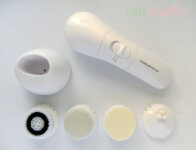


Thank you! Finally someone with education and common sense (you) debunks all this crap.
1/ Thank you Michelle for debunking all these trendy myths with real hard science. And 2/ thank you for making your content accessible by releasing videos and blog posts. I might be a dinosaur in my 30s, but I only have patience to read things and not watch things 😀
So grateful for you and the work you do to bust the BS marketing out there 🙏🏻
thanks michelle, very much appreciate your work!
as i was scrolling i came across an add that showed a posterior torso in bright alarming colours captioned “Five signs your liver is … “ something something – sorry i missed the end as my eyeballs were rolling around & i clicked close. it was like sitting peacefully in the kitchen when a huge noisy blowfly appears out of nowhere
it was replaced with an ad for monash uni which was much more acceptable! sigh of relief. others included specsavers & lipstick(?) or something(?). nothing else that jumped out as inappropriate to what you do.
only mentioning it as i believe it’s possible to filter your ad settings to block such trash from your posts.
cheers!
Cetaphil reformulated their gentle skin cleanser, and I think customer complaints about parabens was the biggest reason why. (They also removed SLS, another misunderstood ingredient.) I don’t like the new formula. I’m so angry that misinformation is causing well tested products to be ruined.
Thank you for this, I was this close to stopping use of my CeraVe moisturizer all bc I saw a similar video from a guy saying he was a dermatologist and it will disrupt your hormones, even though the formula has really been helping repair my skin barrier! It’s all just fear mongering and scare tactics so they’ll go viral.
Please dissect this latest study showing that parabens are hormone disruptors? https://pubmed.ncbi.nlm.nih.gov/36746253/
We posted a briefing note on BeautySciComm! https://beautyscicomm.com/reduction-of-parabens-reverses-likelihood-of-cancer/